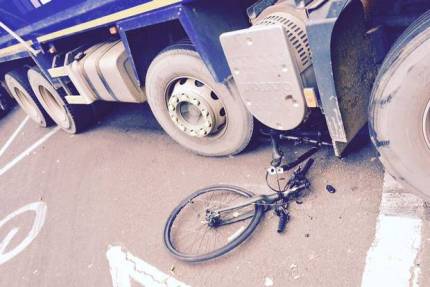Our last post questioned the current effectiveness of the Fleet Operators Recognition Scheme (FORS) of Transport for London (TfL). Below we put forward what we hope will be seen as constructive suggestions that TfL can pursue.
Just a slight injury this time (Photo Evening Standard)
The context
This year (we are just over half way through it) eight cyclists have been killed on London’s roads, of whom no less than seven were killed under the wheels of Heavy Goods Vehicles. Six months’ figures are not a basis for transport policy initiatives, but the point is that about half the cyclists killed on London’s roads for the last couple of decades and more have been killed in this manner. A roughly similar number of pedestrians have been killed under the wheels of lorries. I have represented the Road Danger Reduction Forum, the London Boroughs Cycling Officers’ Group and the London Cycling Campaign (at different times) since the early 1990s in attempts with TfL, the Department for Transport and others to address this issue.
While TfL has made significant efforts in this area through CLoCS and otherwise, we don’t think anything like enough has been done. See our recent posts here and here.
Our approach…
The Road Danger Reduction approach is to reduce danger at source, i.e. from motor vehicular traffic. As with Health and Safety regimes in aviation, maritime and rail safety, and safety at work, the primary objective has to be an adequately safe environment, before placing demands on the potential victims of unsafe practices. In this area this means focusing on the danger posed by HGVs towards other road users – in London primarily cyclists and pedestrians. Car and lorry occupants are also at risk on roads with higher-speed traffic.
…and a word of caution.
Cyclist deaths involving lorries are front page news in London’s main daily newspaper, and crop up in conversations whenever cycling in London is mentioned. I have worked to address this problem because it is urgent and many of the solutions are easy to implement. Any Mayor of London will have a particular interest in bringing these numbers down, so it is an obviously necessary target for transport and road danger reduction professionals to work on. Of all the casualty figures published, it is reasonable to look at deaths first, and to remember that serious injuries where HGVs are involved are particularly likely to be life-changing – and that the feelings of fear from manoeuvres like close overtaking are especially high with HGVs.
But it has to be remembered that only about 5% of killed and seriously injured cyclists in London have been in a collision involving an HGV. The proportion where a construction industry HGV is involved, though significant compared to their share of lorry traffic, is even lower. The same applies to the (less statistically reliable) category of slight injuries. The proportion of pedestrians killed with HGVs involved is far lower than for cyclists. (See Table 1 of TfL’s current Cycle Safety Action Plan: Ratio of cyclist KSI (Killed and Serious Injury) injury and collision involvement by mode share [2010-12])
What all this means is that lorry danger is an extremely important issue to tackle, but not one which we can allow to divert us from the principal source of road danger, which comes from other motor vehicles, particularly cars. It may seem cynical, but sometimes one might be forgiven for thinking that media concentration on this issue allows ordinary motorists to feel that the problem of road danger lies elsewhere. For us, lorry danger needs to be tackled not just because of its high profile, but as just one type of road danger which can and should be addressed properly.
The programme
-
Retro-fitted or new design Safer Lorries
The simple facts of lorry design are that (a) Drivers find it difficult to see around them with traditionally designed high cabs and (b) There are large gaps between the vehicle body and tarmac which facilitate cyclists, other two-wheeler users and pedestrians being pulled under the wheels, leading to particularly severe crushing injuries.
Our view here is simply that such vehicles are not fit for purpose on urban roads where they are anywhere in the vicinity of pedestrians and cyclists. The answer is that only vehicles without these design flaws should be on London’s streets.
We now have a new generation of HGVs that don’t have such problems
O’Donovan Waste Mercedes Benz
As the new generation will not be on the streets instantly, the alternative requirement to make is that existing lorries have retro-fitted (a) transparent door panels (b) infra-red alerting systems performing like LB Ealing’s Cycle Safety Shield which allow drivers awareness of their surroundings, and (c) deeper guards around the front and sides of HGVs to prevent people being so easily pulled under the wheels.
Our understanding is that the cost of measures such as retro-fitting transparent doors , and installing more effective side-guards and alerting systems, can be largely met by reductions in the insurance premiums of the operators.
From 1 September 2015 the Mayor’s Safer Lorry scheme will come into force. In our view – while a step in the right direction – this does not go far enough. It will require HGVs to have basic safety equipment, which most lorries on London’s roads already do. We spent many years getting extra mirrors on to lorries, but these have limited benefits. Proper use of all mirrors is time-consuming (up to 5 seconds to use all properly at each junction and turn) and as a result often does not happen.
At a meeting showcasing better design this year the (now outgoing) Commissioner of Transport for London said:
“TfL are working towards a point where we’ll say if you want to work on one of our sites it’s got to be one of these – we’re not very far away from this. We’ll do everything we can to make this happen.”
We suggest that this point has been reached, and no GLA/TfL construction site should allow HGVs on it if it does not have direct vision (which may include infra-red sensors of the right type) and proper side guards.
And why shouldn’t such restrictions apply to ALL construction sites in London, brought in by agreement between the Boroughs and GLA/TfL? This then rolls onto ALL HGVs in London by extending the Mayor’s Safer Lorry scheme.
We see this element as the priority. Naturally the freight industry wants “incentives” (e.g. additional funding) to bring in such measures, which as we have noted could be self-financing. However, if necessary, financial support could be provided by TfL diverting a few million pounds from unnecessary road building schemes like the Silvertown Tunnel.
We also note that in the concluding comments to the conference by CLoCS chairman Brian Weatherly (do read the full post ) where he said, “When will CLoCS’ work be completed? Volvo has Vision 2020 – no one will be killed by a Volvo HGV in 2020. It would be an excellent goal for everyone in CLOCS to adopt. If we could achieve that we would know CLOCS has done its job.”
Another way to speed up introduction of safer lorries is to exempt them from:
-
A morning rush hour lorry ban
40% of cycling fatalities involving lorries occur in the morning rush hour. A ban on all lorries over 7.5 tonnes between 8am and 9.30am would allow cycle commuters not to have to share space with lorries. There is a strong argument for moving construction vehicle movements out of the rush hour. Time-based bans exist in other cities, and the night-time London lorry ban has been successfully in place for years.
The problem with this idea (which has been suggested by campaigners for many years) is that it is a muck-shifting exercise which means that other (albeit fewer) cyclists will have the same problems at other times of day. It should not be there as a media-friendly “quick win” to distract attention from the more important measures. Nevertheless, it could be on the cards, particularly if it is used as a way of pushing for the safer lorries which might be exempted from this ban.
-
Stronger enforcement
A. Rogue operators.
There is a serious problem with the worst elements of the freight industry: unlicensed, uninsured, untrained lorry drivers, and unsafe vehicles failing numerous requirements – such as unsafe loads or incorrectly recorded driver hours – for safe operation. Trained police officers can spot signs of non-compliance and in well-reported crackdowns have taken dozens of illegally used lorries off the road.
B. “Normal” rule breaking
In freight use, as with other motor vehicle use, it is always important not to over-focus on the worst extremes of behaviour. Indeed, as already said, we see problems associated with HGVs as something of an iceberg tip of road danger. Behaviours by HGV drivers which endanger others, particularly over-close overtaking of cyclists, should be addressed in new versions of “Operation Safeway” and other road traffic policing.
C. Regulation in general
Our previous post criticised the current “softly-softly” approach of TfL’s Fleet Operators Recognition Scheme. There needs to be a shake-up, and increased rigour in the management of lorry operators, drivers and vehicle fleets. Existing best practice standards set up by FORS and CLOCS need to be extended in the future (for example, by investigation of black box technology and devices like pedestrian activated automatic braking systems). For the moment they should be seen as mandatory under a new Safe Lorries Scheme.
Our suggestion is that GLA/TfL can work with Boroughs to require them to pursue the same objectives as TfL has claimed it intends to do with construction projects, possibly making Local Implementation Funding conditional on this.
To be fair to TfL, there are limitations on what it can do. The Traffic Commissioners and Health & Safety Executive need to be given greater powers and resources if we are to have an adequately safe freight industry. Taking unsafe HGVs off the road is of limited value if rogue operators can re-introduce them and continue unsafe practices soon afterwards.
There have been well publicised cases of deaths caused by HGV drivers with histories of persistent and serious driving offences. A key issue is allowing operators access to the records of such cases Potential clients of operators should also be able to have information about lorry operators’ safety records, which are at present confidential and known only to operators themselves.
4. Highway engineering
The highway environment can frequently be engineered so that lorries do not come close to pedestrians or cyclists and any injury is avoided. Also, there is the advantage of protection not just from lorries, but also from other motor vehicles.
We won’t go into the potential disadvantages of segregationist engineering here – difficulty in achieving changed driver behaviour at junctions or inflating the idea that cyclists don’t belong on the road – although there are limitations in potential. (See the discussion here including my comments as rdrf). The RDRF is happy to welcome good quality “Space 4 Cycling” approaches, while voicing concerns about possible disbenefits. Indeed, highway engineering is a key element in reducing road danger for all road users.
Unlike traditional “road safety” engineering based on targeting places characterised by numbers of reported collisions, engineering should be based on other ways of assessing danger . A location like Staples Corner poses similar road danger to cyclists as one like Bow Roundabout, where there have been more cyclist deaths. The reason for the lack of incidents may just be the relative absence of cyclists – often precisely because of the high level of danger presented to them.
5. Training.
Drivers. In our professional work, members of the RDRF Committee e have been involved in the promotion of the Safer Urban Driving module for lorry drivers’ Certificate of Professional Competence. However, we are the first to admit that this training comes low on the list of measures to reduce lorry danger.
Cyclists. Similarly, we have a long record of supporting confidence building cycle training, some of which informs trainees of the problems of cycling near high-sided vehicles in general and HGVs in particular.
However, we do not believe in an “even-stevens” approach, which ignores the difference in potential danger to others of different modes. In this case it makes far more sense to target some 50,000 drivers likely to be behind the wheel of a typical number of some 30,000 HGVs in London daily, rather than about ¼ million daily cyclists out of up to a million people who may cycle in London in a given year. We also doubt that publicity posters – which we have supported as a small element of an overall programme – are of themselves likely to have a significant effect.
Also, even well-trained cyclists make mistakes. They don’t deserve serious injury or death as a penalty for this. After all, highway and motor vehicle engineering has often been based on accommodating rule- or law-breaking driving – with potentially far more negative consequences than accommodating cyclist or pedestrian error.
The first years of this century showed a decline in the chances of London cyclists being hurt or killed in incidents involving lorries. We think this was largely due to a “Safety in Numbers” effect, which can occur because of the increased visible volume of cyclists in parts of London, and which can be assisted by the right kind of cycle training.
However, the benefits of SiN are limited, and a proper programme of addressing the problems involved where cyclists and pedestrians may be hurt in collisions with HGVs has to prioritise measures: 1 (HGV design); 3 (Enforcement) and 4 (Highway engineering).
Conclusion
We have argued at TfL that a Standing Committee on HGV safety should be set up to push through the programme outlined above. Such an overseeing management structure should be introduced by the new Mayor – if it can’t be a legacy of Mayor Johnson. It could lead to a dramatic decline in the cyclist death rate in London – although it mustn’t be left at that.
In order to address what lies behind the vast majority of cyclist (and pedestrian) casualties and the danger presented to them and other road users, we need to extend measures such as those outlined above to all the other sources of road danger. That means moving beyond HGVs to the operation of other fleet vehicles: buses – and above all cars.


